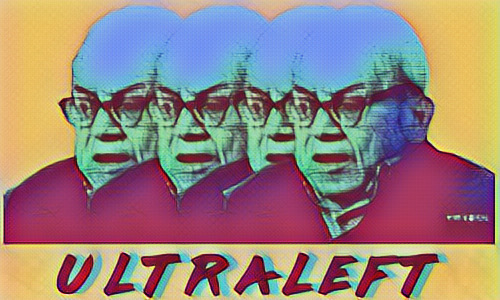Pan-Leftism to Ultra-Leftism
Pan-leftism is an ideology, or the lack there of one, which promotes the notion that Anti-Capitalist Leftists of all shades should cooperate instead of constantly bickering amongst themselves.
Pan-leftists welcome all Anti-Capitalists be they Anarchist; Communists of all shades including Maoists, Trotskyists; Religious Socialists (Such as Liberation Theologists or Islamic Socialists); Democratic Socialists (of the sort who don't support the Capitalist means of production); Syndicalists or any other ideology which supports the working class against Capitalism and Fascism.
But if what unites the Left is only an amorphous anti-capitalism and anti-fascism, then what truly holds us together? Here is what Ultra-Leftism has to offer as a basis for uniting the Left.
Ultra-Leftism emerges from these traditions coming together in the 1960s French ultra-gauche. The term originated in the 1920s in the German and Dutch workers movements, originally referring to a Marxist group opposed to both Bolshevism and social democracy, and with some affinities with anarchism. The ultra-left is defined particularly by its breed of anti-authoritarian Marxism, which generally involves an opposition to the state and to state socialism, as well as to Parliamentary democracy and wage labor. In opposition to Bolshevism, the ultra-left generally places heavy emphasis upon the autonomy and self-organization of the proletariat.
The ultra-left was born and grew in opposition to Social Democracy and Leninism—which had become Stalinism. Against them, it affirmed the revolutionary spontaneity of the proletariat. The German communist left (in fact German-Dutch), and its derivatives, maintained that the only human solution lay in proletarians' own activity, without it being necessary to educate or to organize them inheriting the mantle of the ultra-left after the war.
One variant of ultra-leftist ideas was widely revived in the New Left of the 1960s, and particularly in the May 1968 moment in libertarian socialist movements such as Big Flame, the Situationist International, and the autonomists.
At present, some currents of ultra-leftism have moved away from ultra-leftism's Left communist origins and have adopted a decentralized version of Marxism. Some ultra-leftists have been influenced by autonomism, communization and the theories of Max Stirner. This ideological move has created a divide between traditional left communists and the current ultra-left, mostly on the issue of centralism. Some consider the modern ultra-left a neo-Situationist doctrine inspired, among others, by the works of Guy Debord. Some ultra-leftists are also inspired by the works of Stirner, identifying themselves egoist-communists.
So with the Ultra-Left there are spontaneous movements amongst the working class that can build coalitions. While the Ultra-Left historically stands against authoritarian communism and Social Democracy, it also offers an alternative to an otherwise amorphous Left.



Comments
Post a Comment